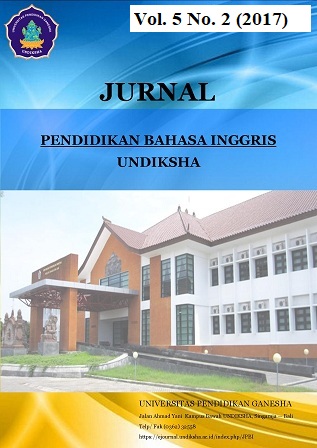THE ANALYSIS OF AFFIXATION IN BALINESE TIYINGTALI DIALECT: DERIVATIONAL AND INFLECTIONAL MORPHEME
DOI:
https://doi.org/10.23887/jpbi.v5i2.14959Abstract
Penelitian deskriptif kualitatif ini bertujuan untuk mendeskripsikan awalan dan akhiran pada dialek Tiyingtali BTD) yang termasuk derivasi dan infleksi. Dua narasumber dari BTD dipilih berdasarkan ruang lingkup: keluarga, kekerabatan, dan tetangga. Data dikumpulkan berdasarkan dua teknik, yaitu: observasi dan wawancara. Beberapa instrument yang digunakan dalam mengumpulkan data yaitu: peneliti sendiri, Daftar kosakata swadesh and nothofer daftar kata. Ada tiga proses dalam menganalisa data, yaitu: data reduction, data display and drawing conclusion. Hasil penelitian menunjukkan bahwa ada dua jenis awalan pada BTD. Awalan itu adalah: {mә-}and {n-} dan ada tiga jenis akhiran yang ditemukan dalam dialek Tiyingtali . Akhiran itu adalah : {ᴧŋ}, {mә}, and {nә}. Selain itu, ada dua awalan yang mengalami derivasi yaitu {mә-} and {n-} dan ada dua macam akhiran ditemukan pada dialek Tiyingtali yang diklasifikasikan sebagai akhiran derivatif. Akhiran itu adalah : {ᴧŋ} and {In}. Sementara itu, awalan yang mengalami infleksi adalah {n-} dan akhiran yang mengalami infleksi adalah {ᴧŋ}{In}{nә}Kata Kunci : morfem derivasi, morfem infleksional, Tiyingtali Dialek (TD)
This descriptive qualitative research aimed at describing the prefixes and suffixes in Balinese Tiyingtali Dialect which belong to derivational and inflectional morphemes. Two informants sample of BTD were chosen based on a set of criteria. The data were collected based on two techniques, namely: observation and interview (listening and noting). The results of the study showed that there were six types of prefix found in Tiyingtali dialect. Those prefixes are: {mә-} and {n-}. Also there were three types of suffixes found existing in Tiyingtali dialect. Those suffixes are: {-ᴧŋ}, {-In}, and {-nә}. Moreover, there are two prefixes belong to derivational prefix, they are: {mә-} and {n-}. There were two kinds of suffixes found in TD that classified as derivational suffix. They are: {-ᴧŋ} and {-In}. Meanwhile, inflectional prefixes are {n-} and inflectional suffixes are {ᴧŋ-}, {In-}, {nә-}.
keyword : derivational morpheme, inflectional morpheme, Tiyingtali Dialect (TD)
Published
2018-07-25
Issue
Section
Articles
License
Authors who publish with the Jurnal Pendidikan Bahasa Inggris Undiksha agree to the following terms:- Authors retain copyright and grant the journal the right of first publication with the work simultaneously licensed under a Creative Commons Attribution License (CC BY-SA 4.0) that allows others to share the work with an acknowledgment of the work's authorship and initial publication in this journal
- Authors are able to enter into separate, additional contractual arrangements for the non-exclusive distribution of the journal's published version of the work (e.g., post it to an institutional repository or publish it in a book), with an acknowledgment of its initial publication in this journal.
- Authors are permitted and encouraged to post their work online (e.g., in institutional repositories or on their website) prior to and during the submission process, as it can lead to productive exchanges, as well as earlier and greater citation of published work. (See The Effect of Open Access)













